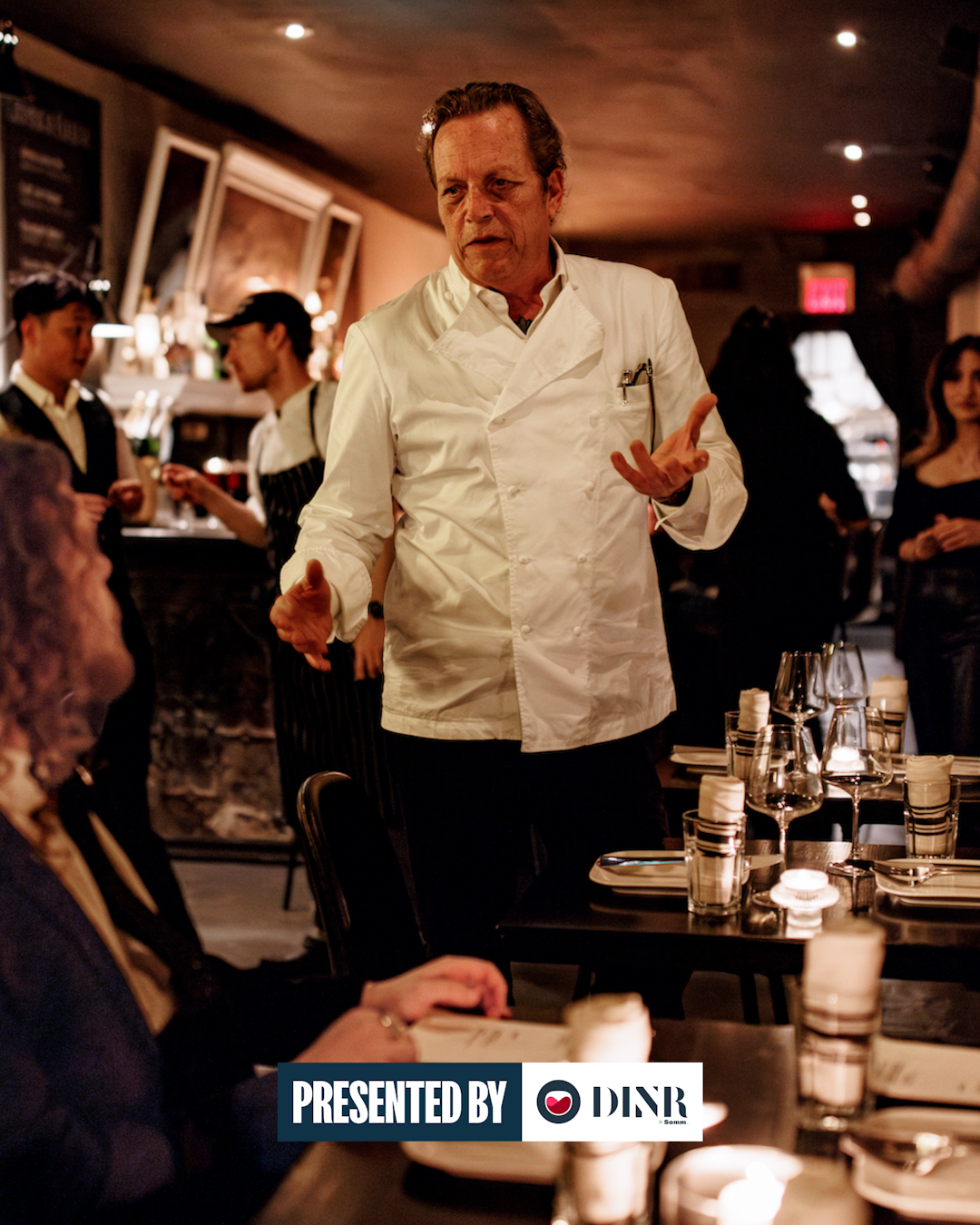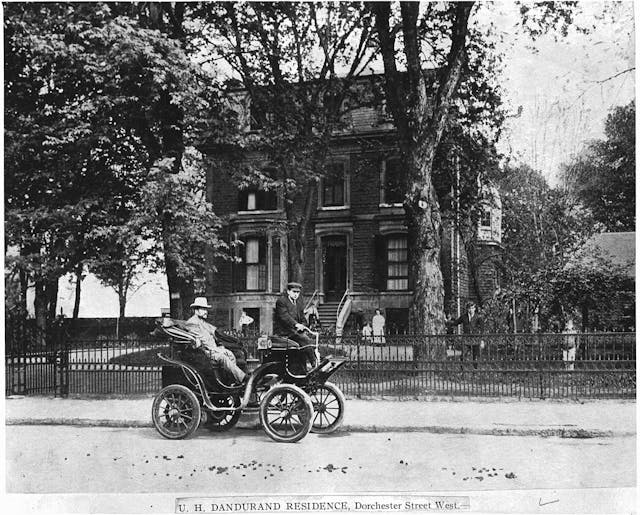How has the Michelin Guide changed the game for Toronto?
One year into the Michelin Guide's arrival in Toronto, we caught up with local chefs to see how its allure is impacting kitchens.
 David Adjey at his restaurant BOUFFE by ADJEY, residing in a neighbourhood basking in the glow of the Michelin Guide. | Photograph: Courtesy BOUFFE by ADJEY
David Adjey at his restaurant BOUFFE by ADJEY, residing in a neighbourhood basking in the glow of the Michelin Guide. | Photograph: Courtesy BOUFFE by ADJEY Favorites Thai BBQ opened its doors in 2019 with a bold approach: A front door to its speakeasy tucked behind the counter of Ossington’s Saint James Coffee Bar. For street traffic, a small neon sign almost intentionally easy to miss that read “Thai BBQ”.
The food was so damn good, word-of-mouth worked its magic. Favorites picked up its first accolade from Toronto Life, named one of the Best Emerging Restaurants in the city.
Before that issue could hit newsstands, however, the pandemic swooped in hard and fast. Even when the restrictions were lifted and the Ossington strip sprung back to life, the damage was done. Awareness of a gem tucked behind a coffee shop had seemingly dissipated.
“I heard so many people walking by like ‘… oh shit what is this place? It looks like a restaurant,’” recalls head chef Ronnie Xu. “It was, like, we've been here for so long and nobody even knows us.”
Still, Xu knew he was still putting out some of the best Thai food in the city—authentic recipes, local ingredients, hours of extra prep time (sacrificing even a chunk of service hours to ensure their own powders were ground fresh daily)—but what Xu also knew was that not nearly enough people were enjoying it.


A look at the finer things inside Favorites Thai BBQ. | Photograph: Instagram / @myfavethai
The things we focus in on, it’s not to get the Michelin … we want our customers to be happy with the food that they're eating. If they're happy when they’ve left the door—that's our priority.
All pan, no flash
It all changed when Michelin called. In a flash, Xu and his team found themselves at a ceremony where Favorites would earn the distinction of landing a spot on the city’s first Bib Gourmand list in 2022.
From then on the restaurant saw a slow, gradual uptick in visitors. By summer, they were filling every seat every night, with many citing the Bib as the source of their patronage. That’s been more or less par for the course ever since.
“It's definitely nice for a restaurant to earn it because I think that's like the way to tell a restaurant you're doing a great job,” says Xu.
For Xu, winning the Bib was not part of the business plan. The core to their success was the experience they had hustled to create.
“The things we focus in on, it’s not to get the Michelin … we want our customers to be happy with the food that they're eating. If they're happy when they’ve left the door—that's our priority.”
Xu’s sentiment is commonly held by most chefs here who described the guide—and its impact on the city one year in—as a welcome acknowledgment for one of the world’s great food cities while also denying it has impacted or altered their approach in any way.


Vibes are up for David Adjey and his restaurant BOUFFE by ADJEY. | Photograph: Courtesy BOUFFE by ADJEY
The focus has to be your staff, making them happy. Then, with their happiness, it's the next step: Now we're going to build experiences.
"Everyone benefits"
“If you look at Michelin Bibs that are in just this little tiny area, it's phenomenal,” notes David Adjey over a glass of wine at his restaurant BOUFFE by ADJEY, only a few blocks away from Favorites.
For Adjey, obsessing over individual awards and how to win them was a waste of time. Instead, the guide was a simple opportunity to celebrate the collected uplift of Toronto’s food scene as a whole.
“We're just in this intersection of cool. Yeah, you get a bit cheesy, you get a star, but you're gonna get all this attention," he says.
"A lot of traffic goes to the restaurant that gets those awards. But everyone, everyone benefits.”
While BOUFFE is not in the Guide, Adjey is no stranger to the level of dedication it takes to be listed. On television for a chunk of his career with shows like Restaurant Makeover and Iron Chef, he had the chance to spend plenty of time in and around three-star restaurants as both a cook and customer.
BOUFFE is very much intended as a departure from that world, a simple testament to the city and food he loves. The “french(ish)” bistro carries plenty of recognizable touchpoints of fine French cuisine, but the restaurant's execution is unapologetically buttoned down and accessible for any Torontonian looking for a good night out.


"A lot of traffic goes to the restaurant that gets those awards. But everyone, everyone benefits.” | Photograph: Courtesy BOUFFE by ADJEY
It’s a place where the majority of energy and decision making is focused on ensuring customers have fun, versus the stately white tablecloth experiences that dominate the upper echelons of the guide internationally.
It's a different process than aligning your establishment simply for award recognition, one that starts first and foremost with taking care of your staff—a metric not easily accounted for in most guides.
“If you make an environment where it's pretty cool to come to work, the journey from 5pm to midnight is just so easy,” adds Adjey. “The focus has to be your staff, making them happy. Then, with their happiness, it's the next step: Now we're going to build experiences.”

People who have not worked in that kitchen have absolutely no clue what the discipline level is like to work in that environment, under that pressure.
Been there, doing it
No one is perhaps better at speaking to the toll awards can take on staff than executive chef Jordan Sclare of Chotto Matte, which touched down in Toronto’s Financial District in 2019.
On the surface, Chotto Matte seems to have the pomp and circumstance of an international fine dining behemoth until you step into the sleek Bay Street enclave and are transported to an oasis somewhere between the DJ booth, the sizzling robata grills, graffiti, and the intermingling aromas of the Peruvian and Japanese cuisines.
It’s a far departure from the military precision of Gordon Ramsay's eponymous three-star spot in Chelsea where Sclare cut his teeth as a young chef. Instead, Chotto Matte is a celebration of joy over stifling perfection.
“I worked for over two and a half years in a three Michelin star restaurant in London, at the time there were 600,000 restaurants in London and only one of them had three Michelin stars,” Sclare says. “People who have not worked in that kitchen have absolutely no clue what the discipline level is like to work in that environment, under that pressure.”
After two and a half years, Sclare opted for a short sabbatical to learn Asian cuisine. After a chance introduction from an old friend and colleague to Nikkei cooking, he never looked back.
“I can tell you because getting the Michelin Guide now in Toronto is like me going back in time twenty years,” Sclare notes when asked for how he predicts the guide may impact Toronto’s kitchens over the next decade.
“Those guys who say that they don't create for the guide? As soon as they get it, they might change their view.”

Toronto is one of my pleasures... I feel like we've been there quite a few years now and I feel like it deserves more internationally.
Predictions and predilections
Sclare sees a lot on the horizon of Toronto's dining scene now that the guide has arrived and embedded itself: How restaurants will begin popping up with the explicit goal of making it to the top of the guide in the next few years; friendly competition; the pressure that comes with maintaining the Bib or a Star once it is bestowed.
Slowly but surely, the stage will be set for Toronto’s guide to expand given the breadth of talent in the city, a boon that will only work to lift Toronto’s international standing.
Still, Sclare has a warning for those first Toronto chefs that set out to make it to the mountaintop: “Go to a three Michelin star restaurant menu, and you look at it 10 years ago compared to now, and you won't see much change on it at all—not much evolution or growth,” he says.
“They think as soon as they change something, they will lose a star … they crack the code of what three Michelin stars is and then they don't really change anything.”
It’s the distinction between the sacrifices it takes to make one once-in-a-lifetime meal, staking a claim among the restaurants with years-long waitlists, versus the sacrifices it takes for a restaurant to genuinely build up and serve a community that keeps coming back again and again.
The latter approach, Sclare points out, is what put Toronto on the map for him in the first place.
“Honestly, genuinely, Toronto is one of my pleasures. It's just clean, it's headache-free—I think highly of Toronto food scene,” Sclare says.
“I feel like we've been there quite a few years now and I feel like it deserves more internationally.”
Whether in the Guide or not, every Torontonian knows how hard it is to get a table at the city’s best restaurants on a whim. Last-minute reservation app DINR connects you with the city's busiest restaurants—including those mentioned in this piece. Download the app today, and get to enjoying your night out.

![The Bulletin: Local heat for low-temp nights 🫕 [Issue #52]](/_next/image?url=https%3A%2F%2Fthemain.ghost.io%2Fcontent%2Fimages%2F2023%2F11%2F273745227_5038428359553145_7479238073259449741_n-1.jpg&w=640&q=75)
